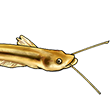https://doi.org/10.1111/jbi.15144
https://onlinelibrary.wiley.com/doi/ful ... /jbi.15144
ABSTRACT
Aim
The bullhead catfish , an early-diverging clade within the genus Tachysurus, exhibits characteristics indicative of an ancient origin and potential cryptic divergence. This study aims to elucidate the evolutionary processes underlying T. argentivittatus s.l. by examining the impacts of complex paleotectonic and drainage rearrangements in East Asia. Additionally, we aim to uncover potential cryptic diversity within this widespread species and explore the mechanisms behind its conserved morphology.
Location
East China.
Taxon
Bullhead catfish Tachysurus argentivittatus (Siluriformes: Bagridae).
Methods
We sampled 302 individuals of the currently recognised T. argentivittatus from nine localities across East China, covering over 5000 km of its latitudinal range. A concatenated dataset of two mitochondrial and four nuclear genes was used for phylogenetic reconstruction using Bayesian inference (BI) and Maximum Likelihood (ML) methods. Divergence times between main lineages of T. argentivittatus s.l. were estimated with a mitochondrial two-gene concatenated dataset in BEAST v.2.5.2, applying four secondary calibration points. A 3D principal component analysis (PCA) of 26 morphological traits was employed to diagnose molecular operational taxonomic units (OTUs) identified in the phylogenetic analysis.
Results
Molecular phylogenetic analyses revealed deep divergences within T. argentivittatus s.l., dating back to at least the early Miocene, resulting in three geographically isolated lineages. Coupled morphometric and meristic analyses indicate the subtle but consistent phenotypic differences among lineages. Our findings support the hypothesis that T. argentivittatus s.l. represents a species complex comprising three phenotypically similar yet distinct species. While T. argentivittatus s. str. is restricted to the Pearl River basin, populations from the Yangtze and Amur Rivers are recognised as a distinct species, T. mica, previously considered a synonym of T. argentivittatus. The population from Hainan Island represents a novel taxon, which should be formally described in future studies. We also discuss the biogeographical implications of our findings.
Main Conclusions
Time-calibrated phylogenetic analyses suggest that the ancestor of T. argentivittatus s.l. originated during the Paleogene. The uplift of the Tibetan Plateau since the Oligocene/Miocene boundary, leading to topographic inversion and fluctuations in sea levels, has significantly influenced the dispersal and diversification of the T. argentivittatus complex, including rearrangements and intermittent connections of large East Asian rivers. The reduction in phenotypic variation among these lineages of T. argentivittatus may be explained by phylogenetic niche conservatism and niche tracking.





